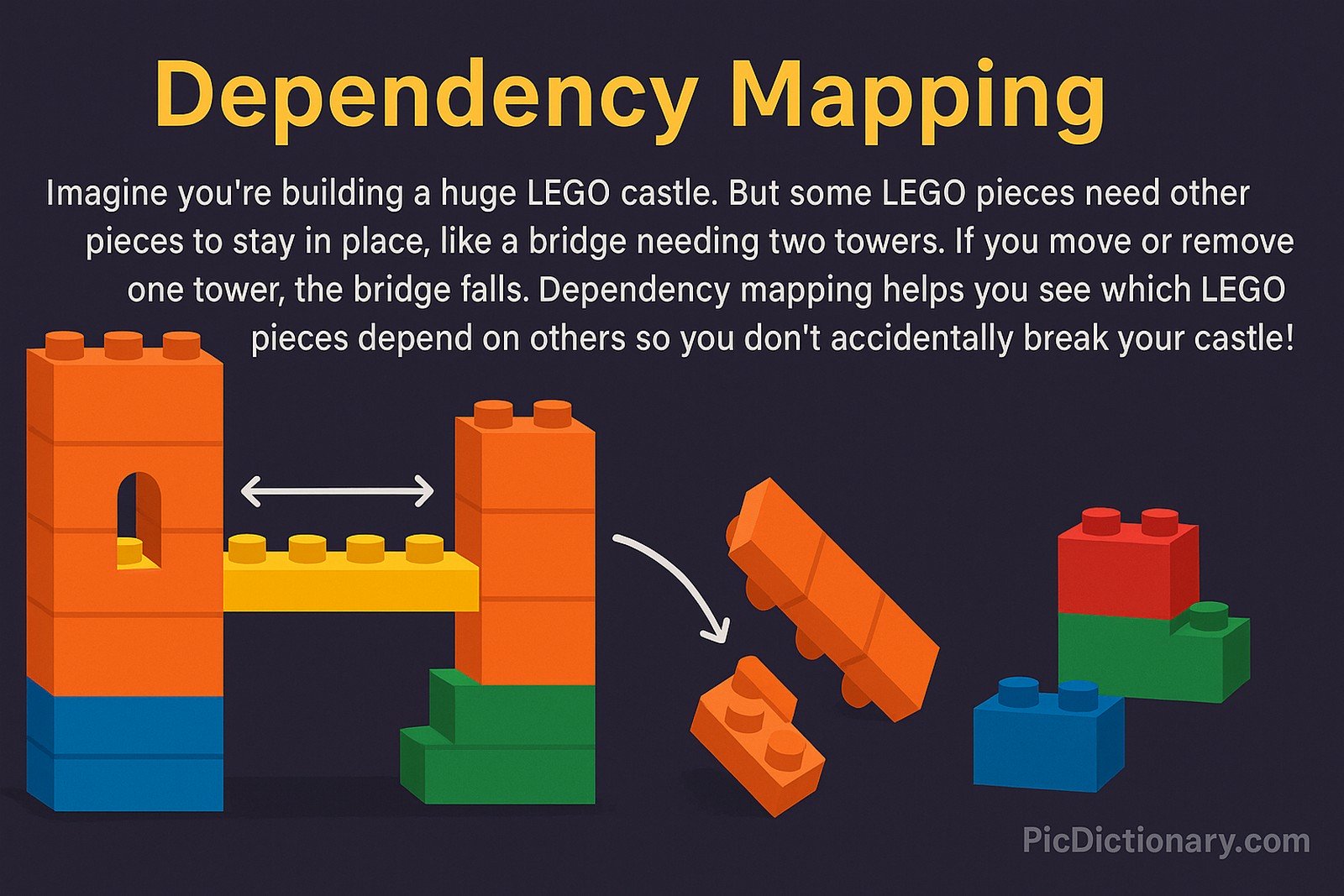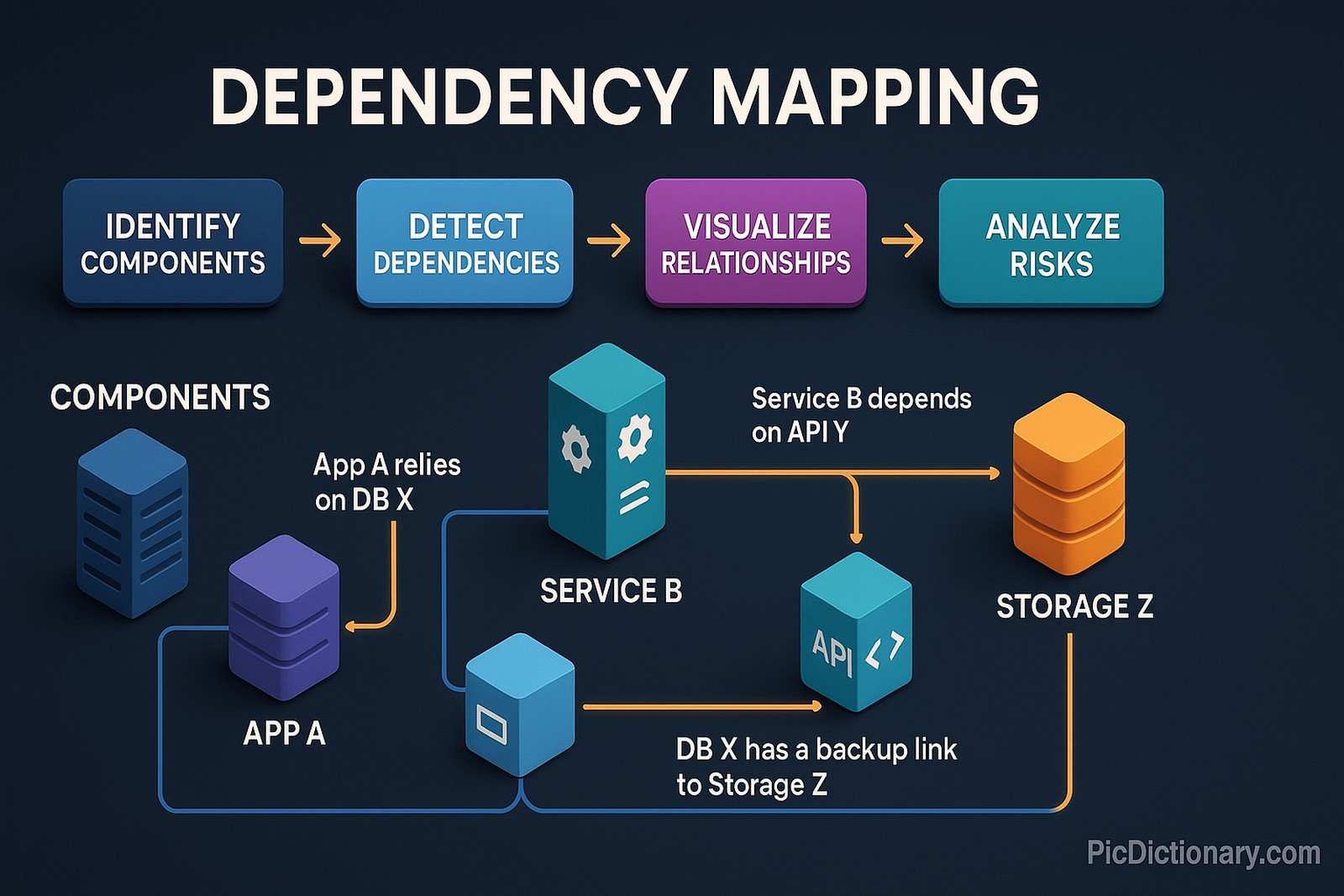Dependency Mapping

Quick Navigation:
- Dependency Mapping Definition
- Dependency Mapping Explained Easy
- Dependency Mapping Origin
- Dependency Mapping Etymology
- Dependency Mapping Usage Trends
- Dependency Mapping Usage
- Dependency Mapping Examples in Context
- Dependency Mapping FAQ
- Dependency Mapping Related Words
Dependency Mapping Definition
Dependency mapping is the process of identifying and visualizing the relationships between different components within a system. This technique is widely used in software engineering, IT infrastructure, and business processes to understand dependencies between applications, databases, services, or system components. By mapping dependencies, organizations can optimize performance, improve fault tolerance, and enhance change management strategies.
Dependency Mapping Explained Easy
Imagine you’re building a huge LEGO castle. But some LEGO pieces need other pieces to stay in place, like a bridge needing two towers. If you move or remove one tower, the bridge falls. Dependency mapping helps you see which LEGO pieces depend on others so you don’t accidentally break your castle! In the computer world, software and systems also rely on each other, and dependency mapping helps track these connections.
Dependency Mapping Origin
The concept of dependency mapping emerged alongside complex software systems and IT networks. As applications and infrastructures grew in scale, engineers needed systematic ways to track dependencies to prevent system failures and inefficiencies. The idea became more prevalent in the late 20th century as businesses started using distributed computing and cloud-based environments.
Dependency Mapping Etymology
The term “dependency mapping” is derived from "dependency," meaning reliance between components, and "mapping," which refers to visualizing or documenting those relationships.
Dependency Mapping Usage Trends
With the rise of cloud computing, microservices, and DevOps, dependency mapping has gained significant importance. Organizations now use it to manage large-scale IT environments, reduce downtime, and enhance cybersecurity by identifying weak points in system architecture.
Dependency Mapping Usage
- Formal/Technical Tagging:
- IT Infrastructure
- Software Development
- Systems Architecture
- Typical Collocations:
- "dependency mapping tool"
- "application dependency mapping"
- "network dependency mapping"
- "service dependency visualization"
Dependency Mapping Examples in Context
- A company migrating its applications to the cloud uses dependency mapping to determine which services interact and must be moved together.
- An IT team performing a system upgrade maps dependencies to prevent breaking critical connections.
- Cybersecurity professionals use dependency mapping to identify vulnerable points in network architectures.
Dependency Mapping FAQ
- What is dependency mapping?
Dependency mapping is a process that identifies and visualizes relationships between software components, applications, or systems. - Why is dependency mapping important in IT?
It helps organizations understand system interactions, reduce risks, and improve troubleshooting and change management. - What tools are used for dependency mapping?
Common tools include Dynatrace, ServiceNow, AppDynamics, and Microsoft Dependency Tracker. - How does dependency mapping support cloud migration?
It helps businesses map dependencies before moving applications to the cloud, ensuring smooth transitions without service disruptions. - Can dependency mapping improve security?
Yes, by identifying weak links and potential attack points in system architectures. - What industries benefit from dependency mapping?
Industries like healthcare, finance, and e-commerce use it to manage IT infrastructure and optimize workflows. - Is dependency mapping only for IT systems?
No, businesses also use it for process mapping and workflow optimization. - How does dependency mapping work in DevOps?
It helps DevOps teams track dependencies in CI/CD pipelines, reducing deployment risks. - What challenges are associated with dependency mapping?
Challenges include keeping maps updated and dealing with complex, large-scale systems. - Can dependency mapping be automated?
Yes, various tools automate mapping by scanning system architectures and analyzing dependencies.

Dependency Mapping Related Words
- Categories/Topics:
- IT Operations
- Software Engineering
- Cloud Computing
Did you know?
Dependency mapping played a crucial role in the development of cloud computing. As businesses transitioned to cloud-based services, they needed to track complex interdependencies between on-premise and cloud applications. This led to the rise of advanced dependency mapping tools that automate discovery, monitoring, and optimization of cloud environments.
PicDictionary.com is an online dictionary in pictures. If you have questions or suggestions, please reach out to us on WhatsApp or Twitter.Authors | Arjun Vishnu | @ArjunAndVishnu

I am Vishnu. I like AI, Linux, Single Board Computers, and Cloud Computing. I create the web & video content, and I also write for popular websites.
My younger brother, Arjun handles image & video editing. Together, we run a YouTube Channel that's focused on reviewing gadgets and explaining technology.



Comments powered by CComment